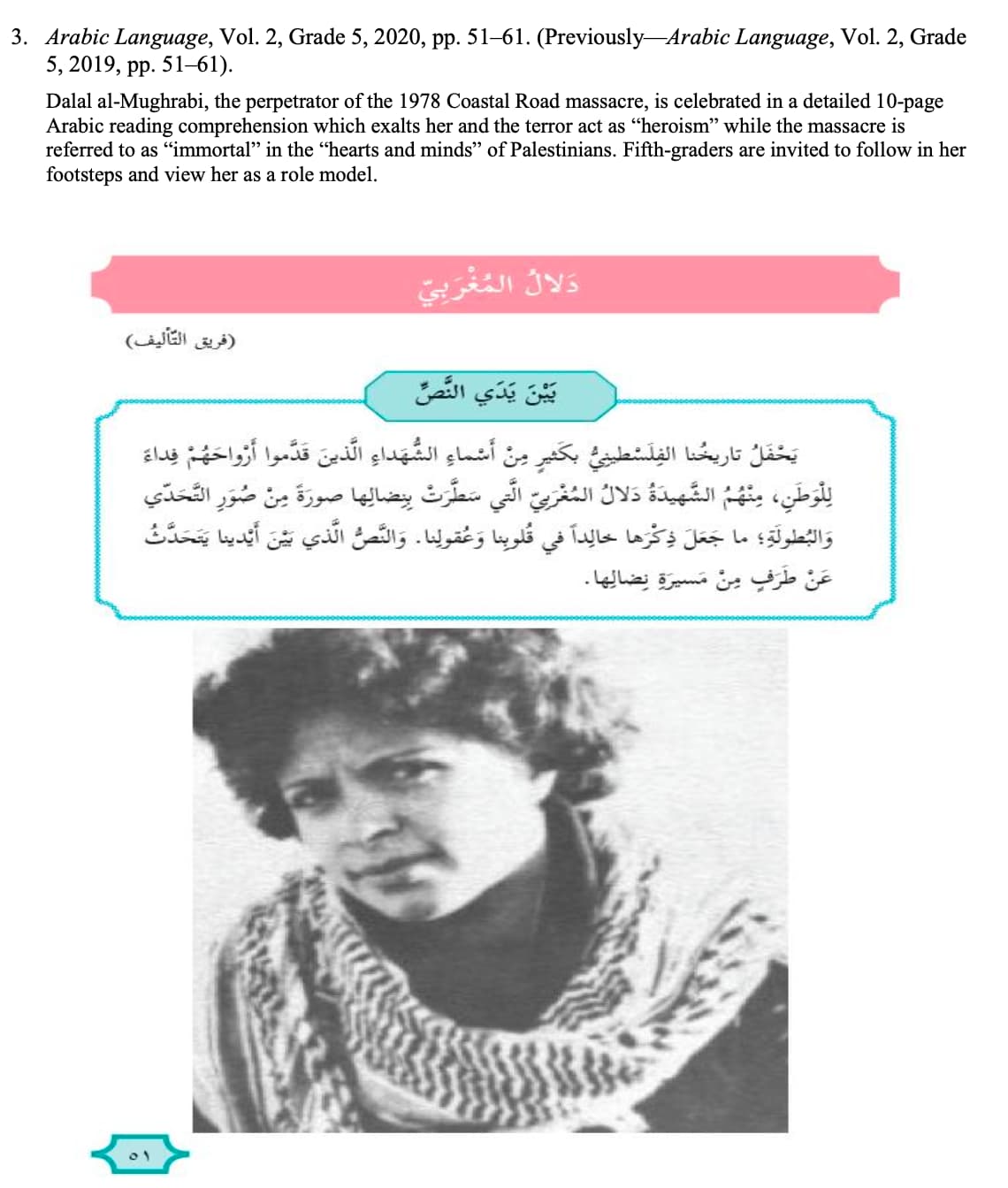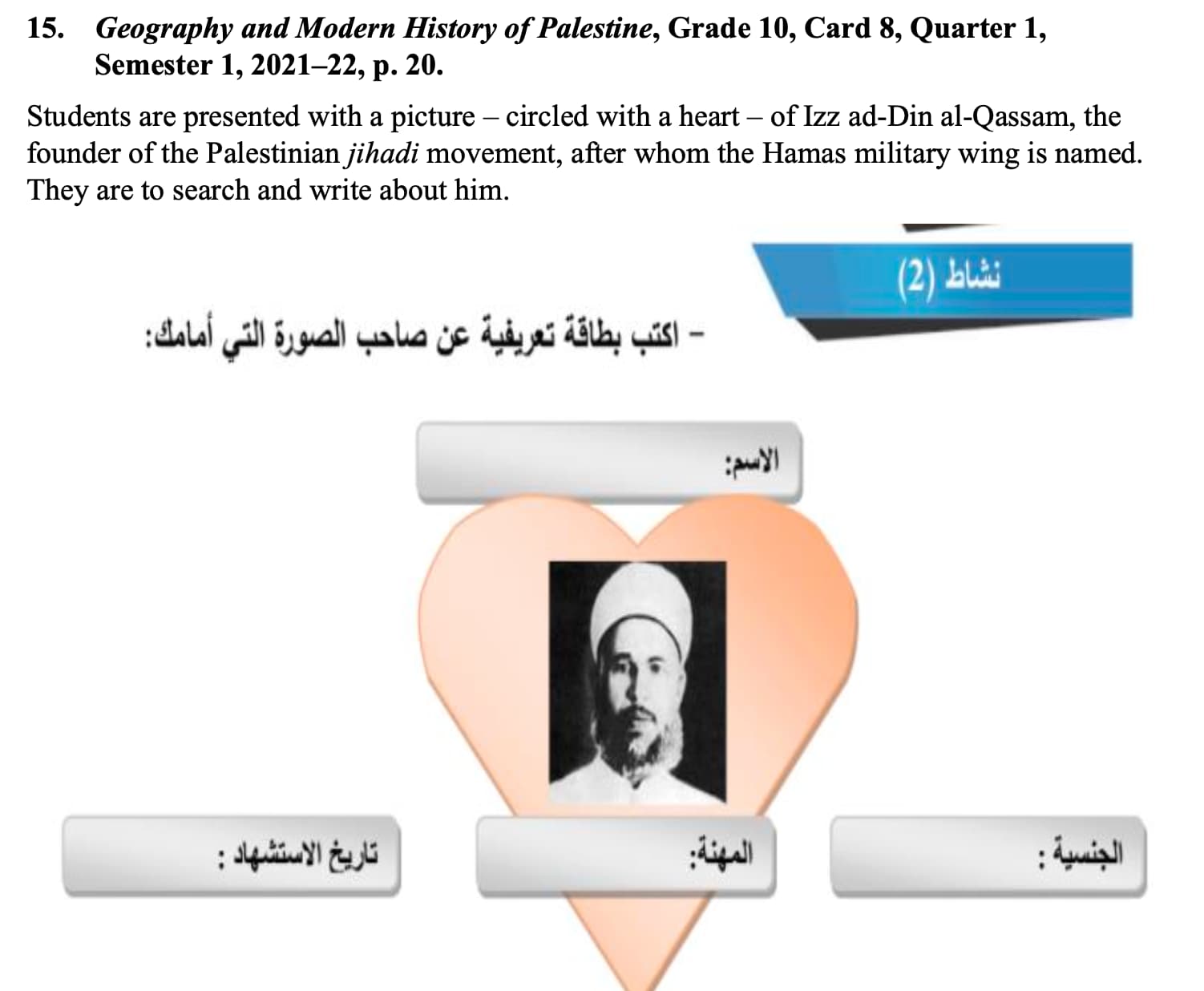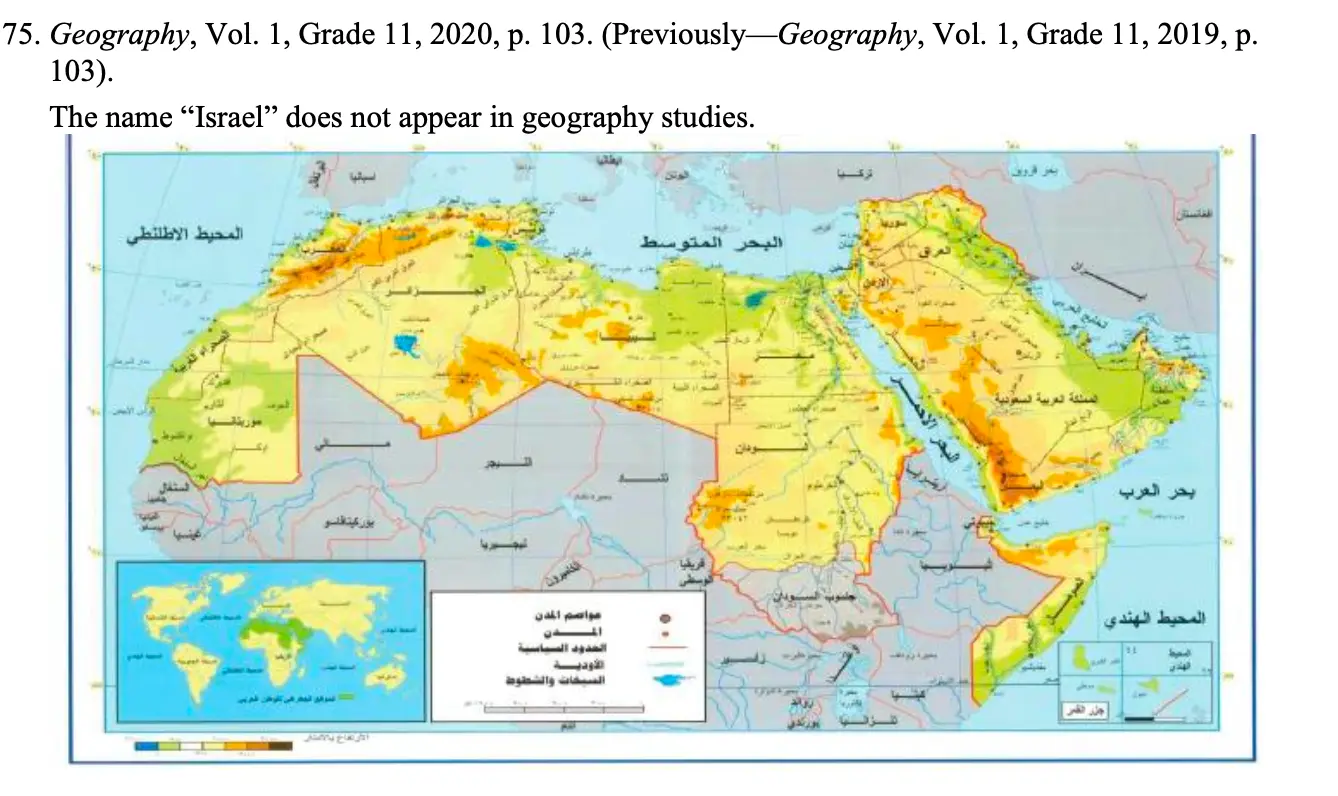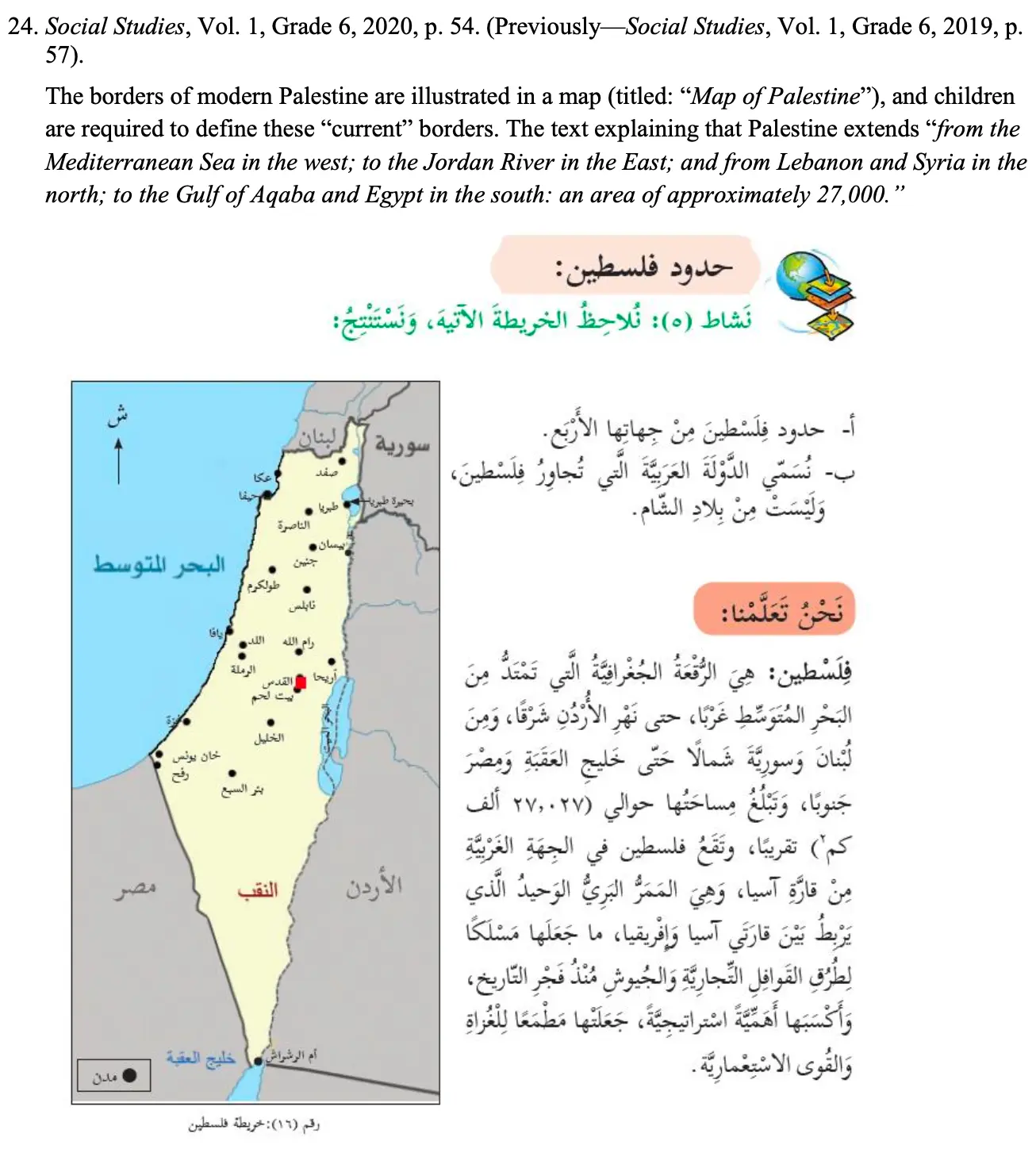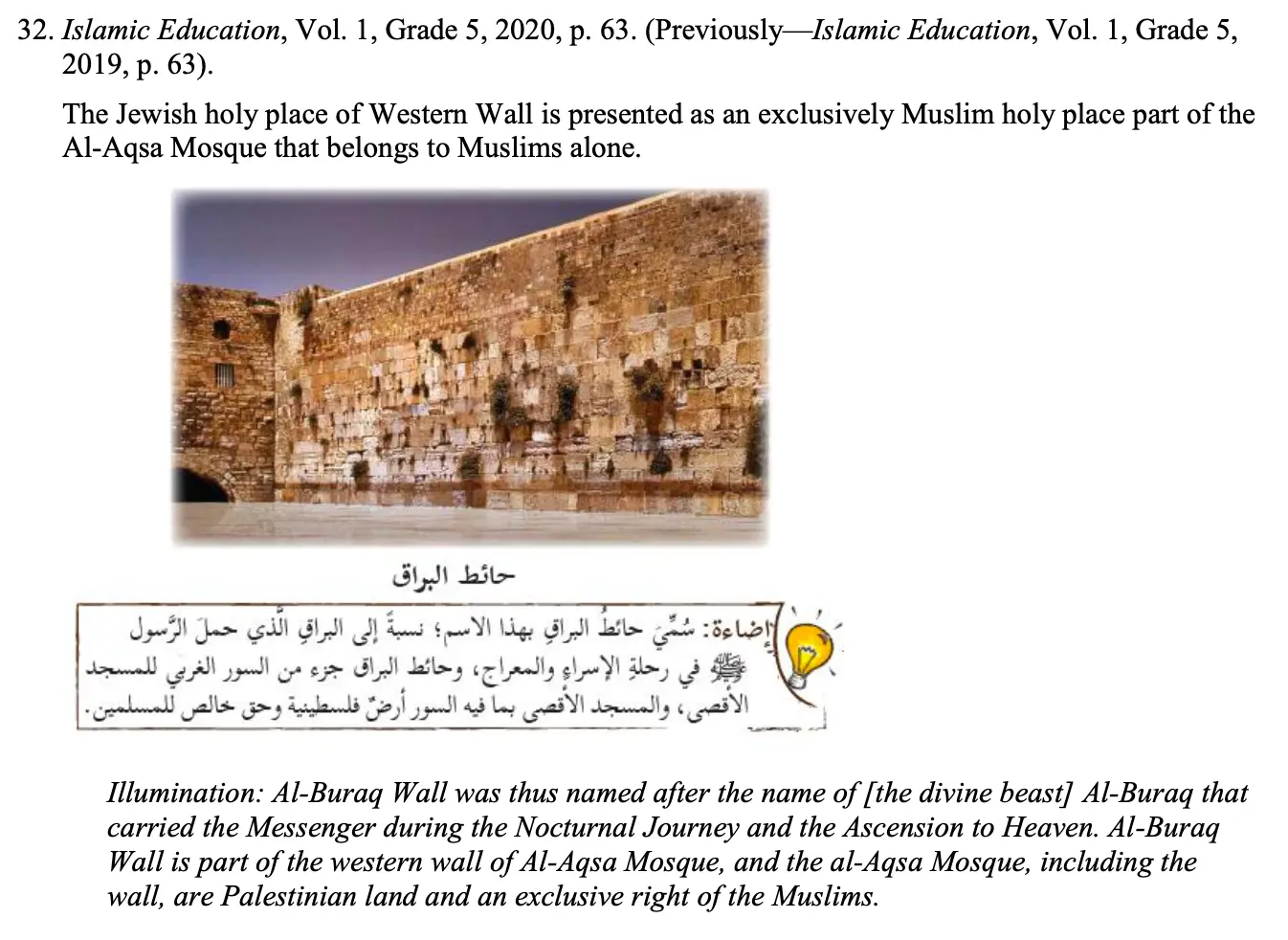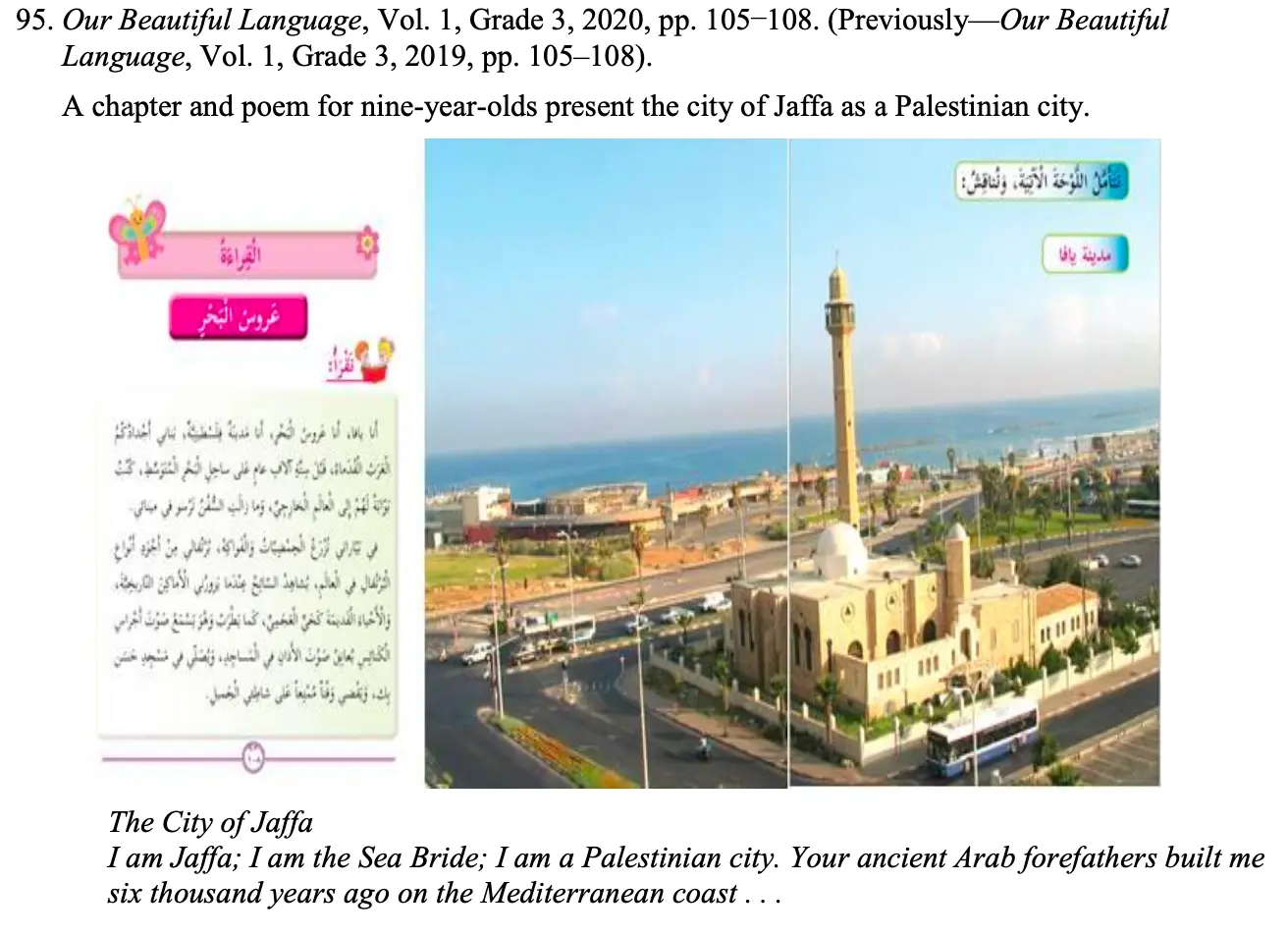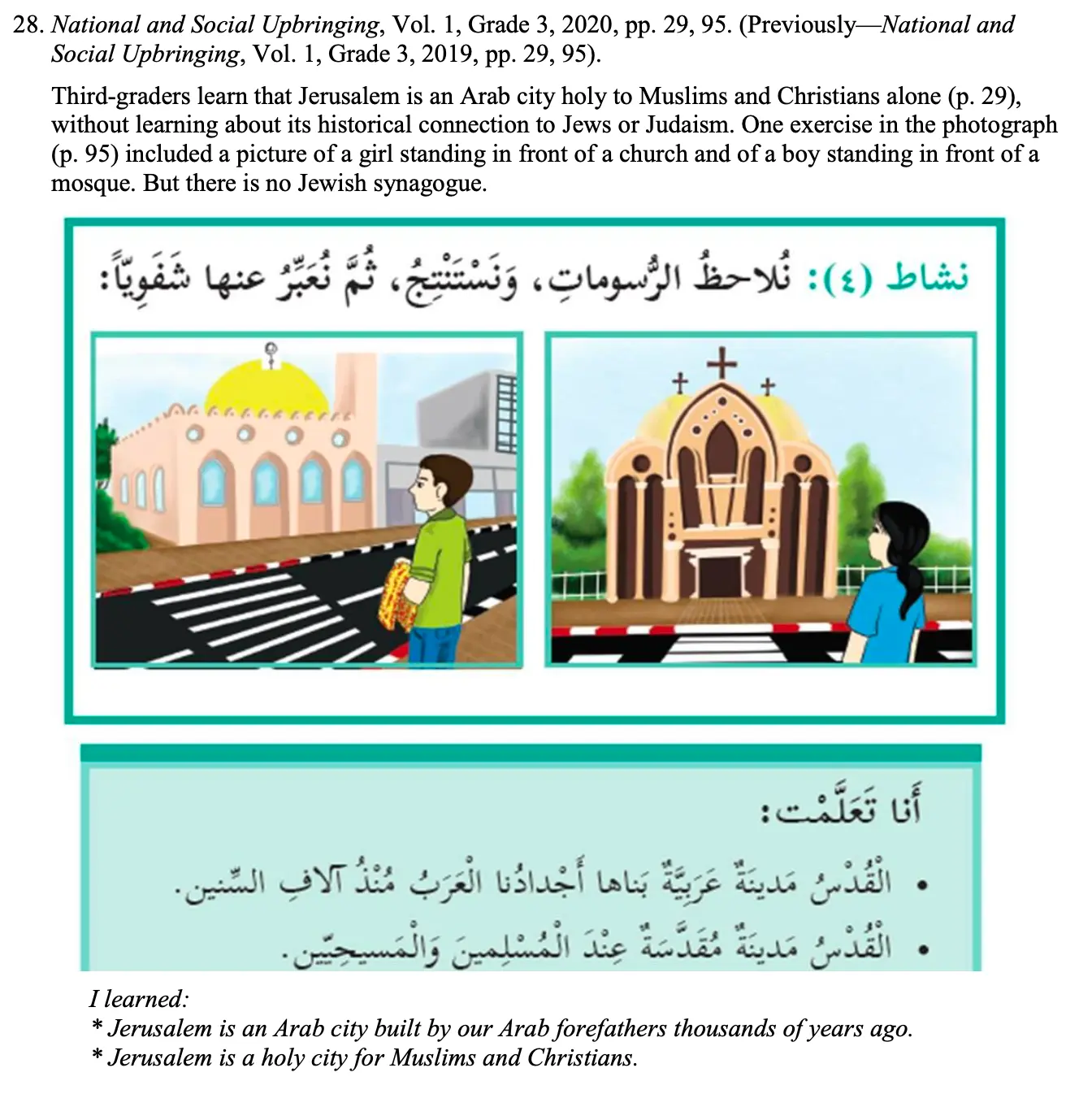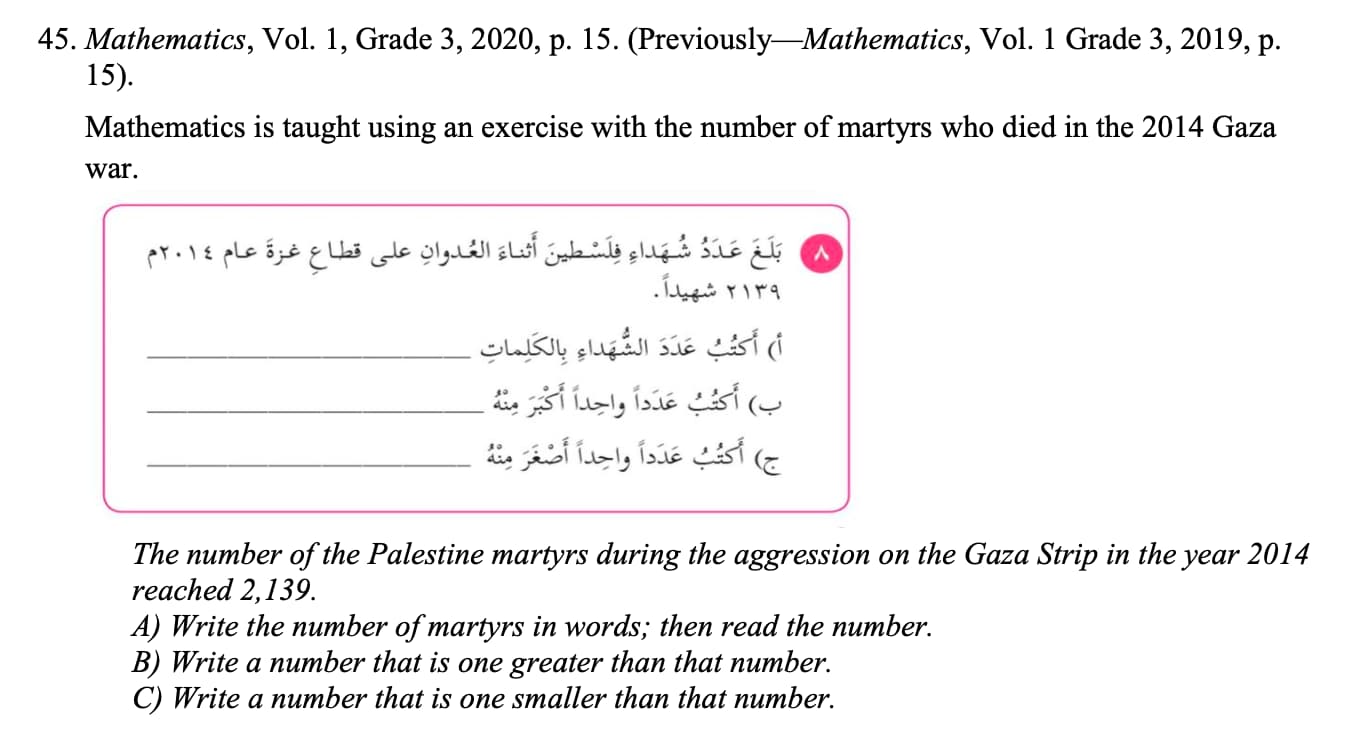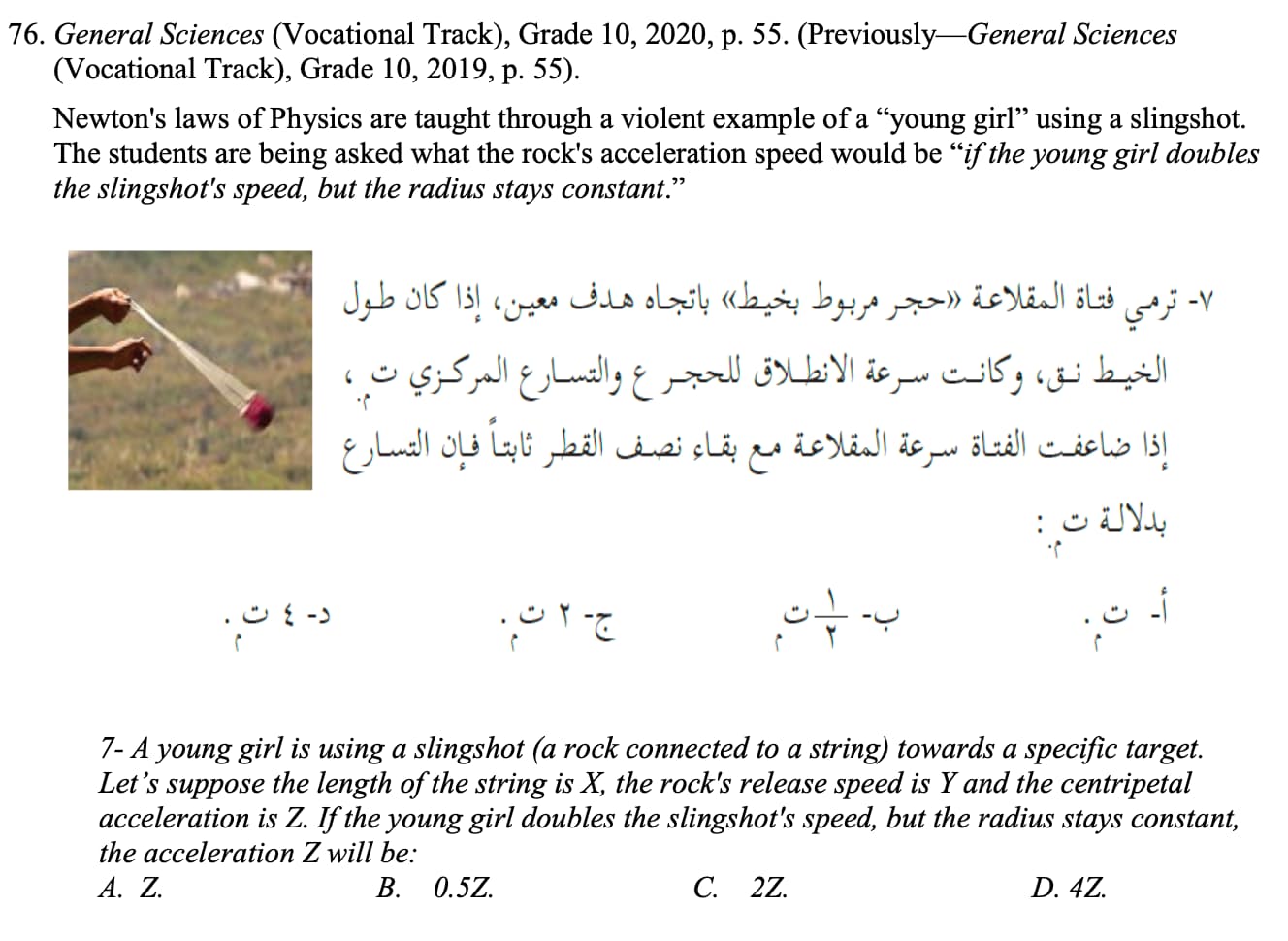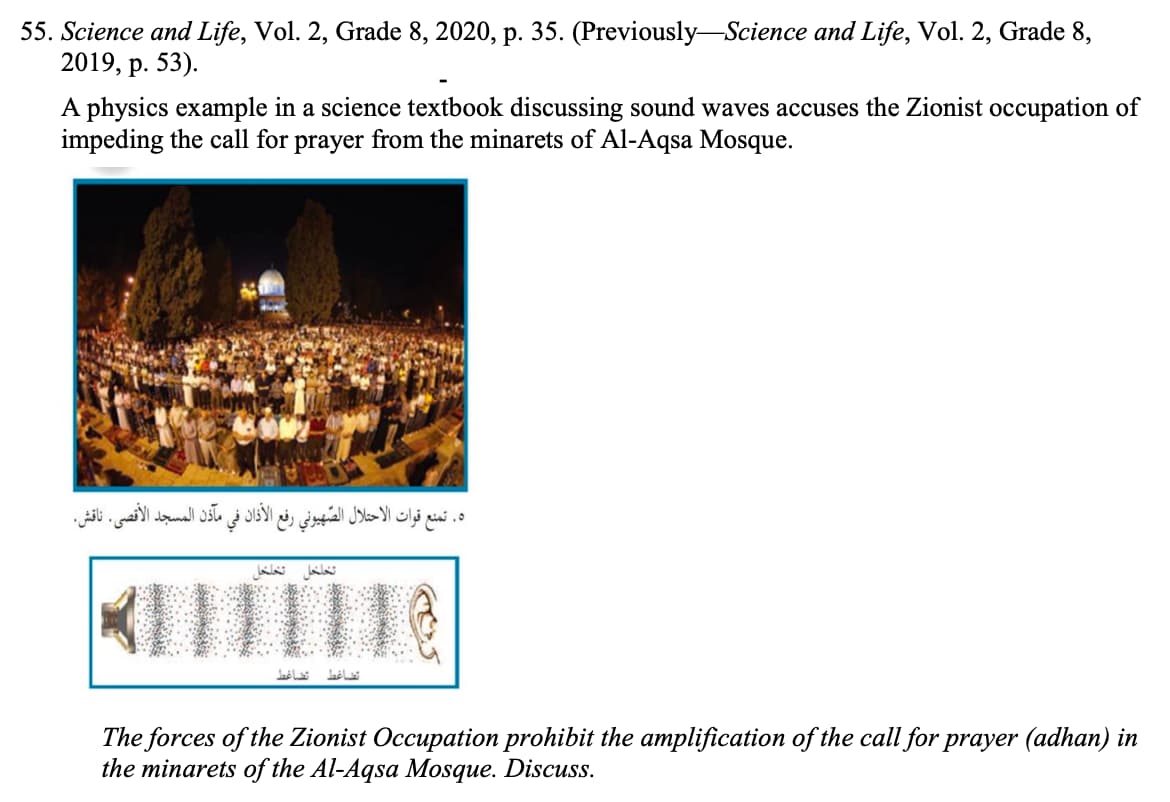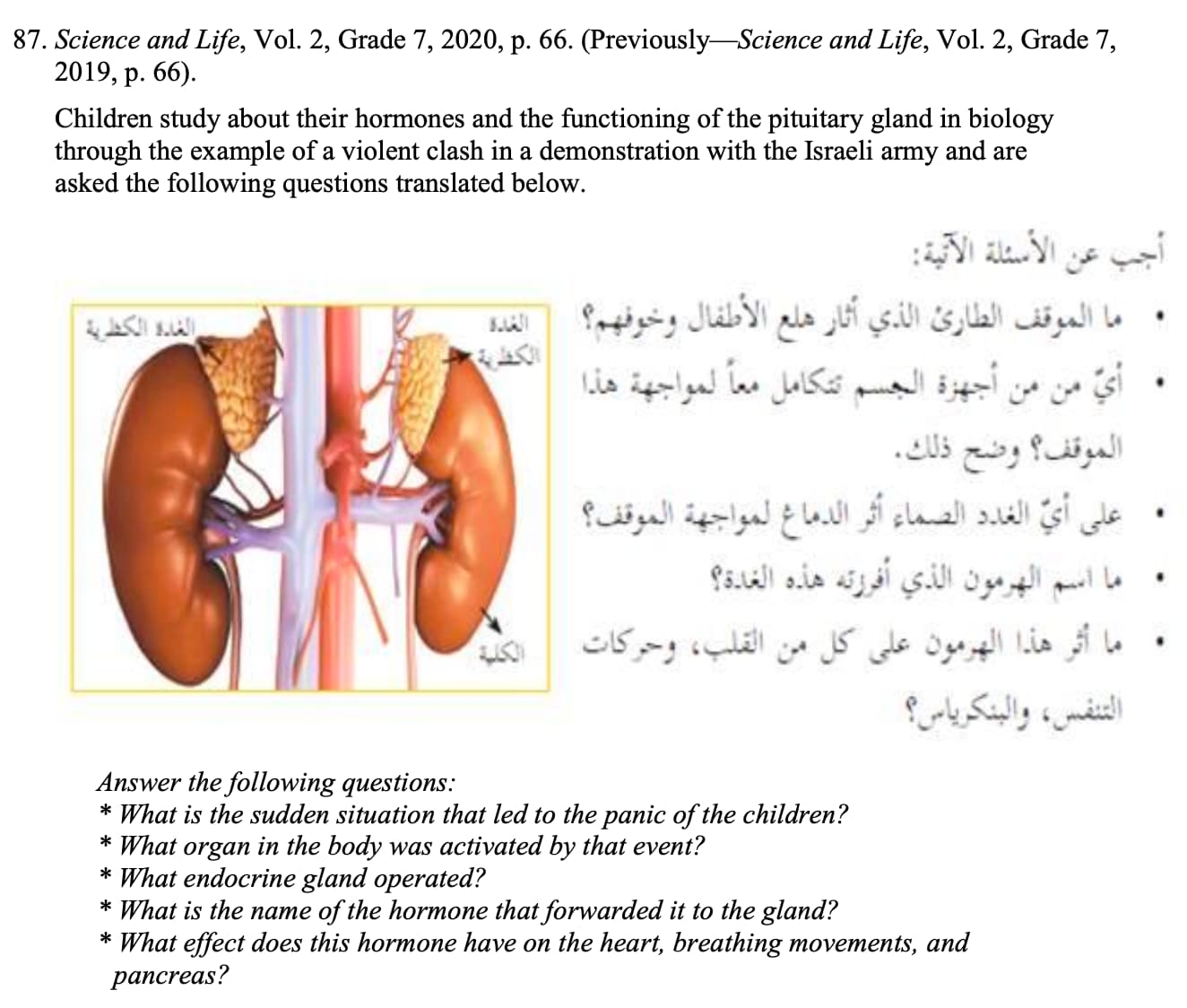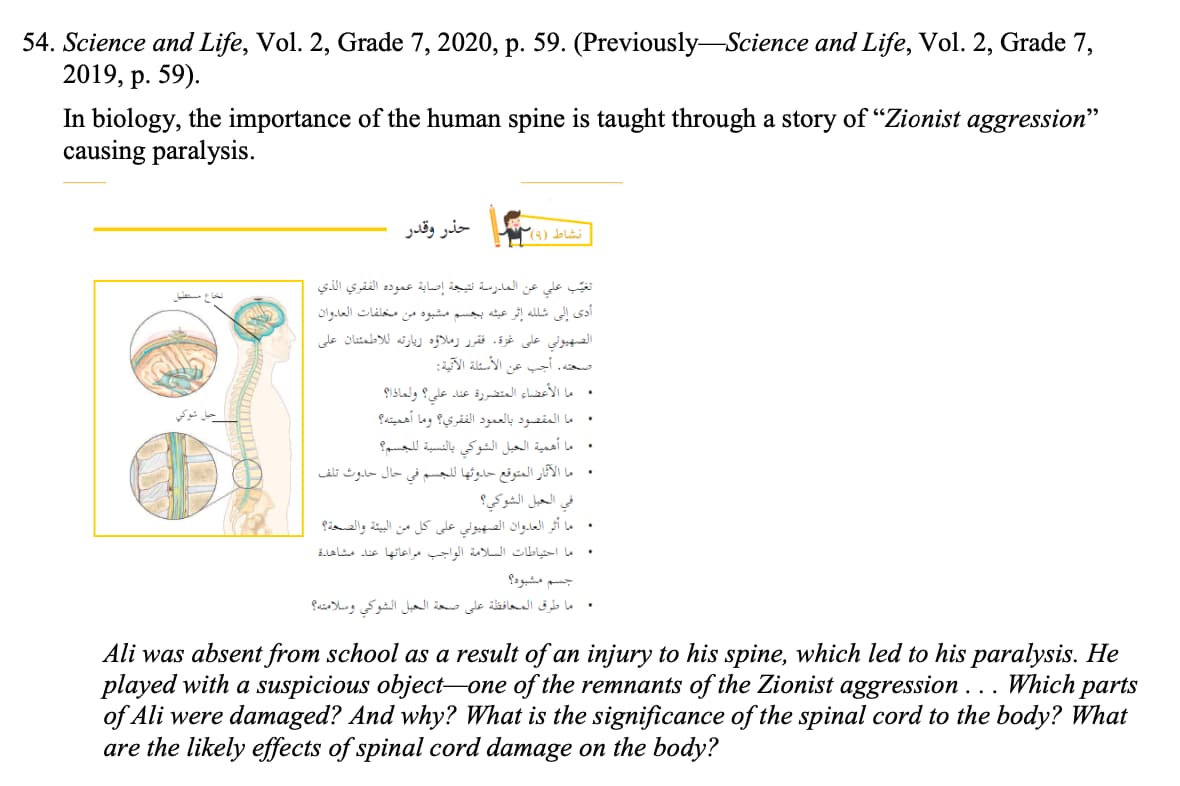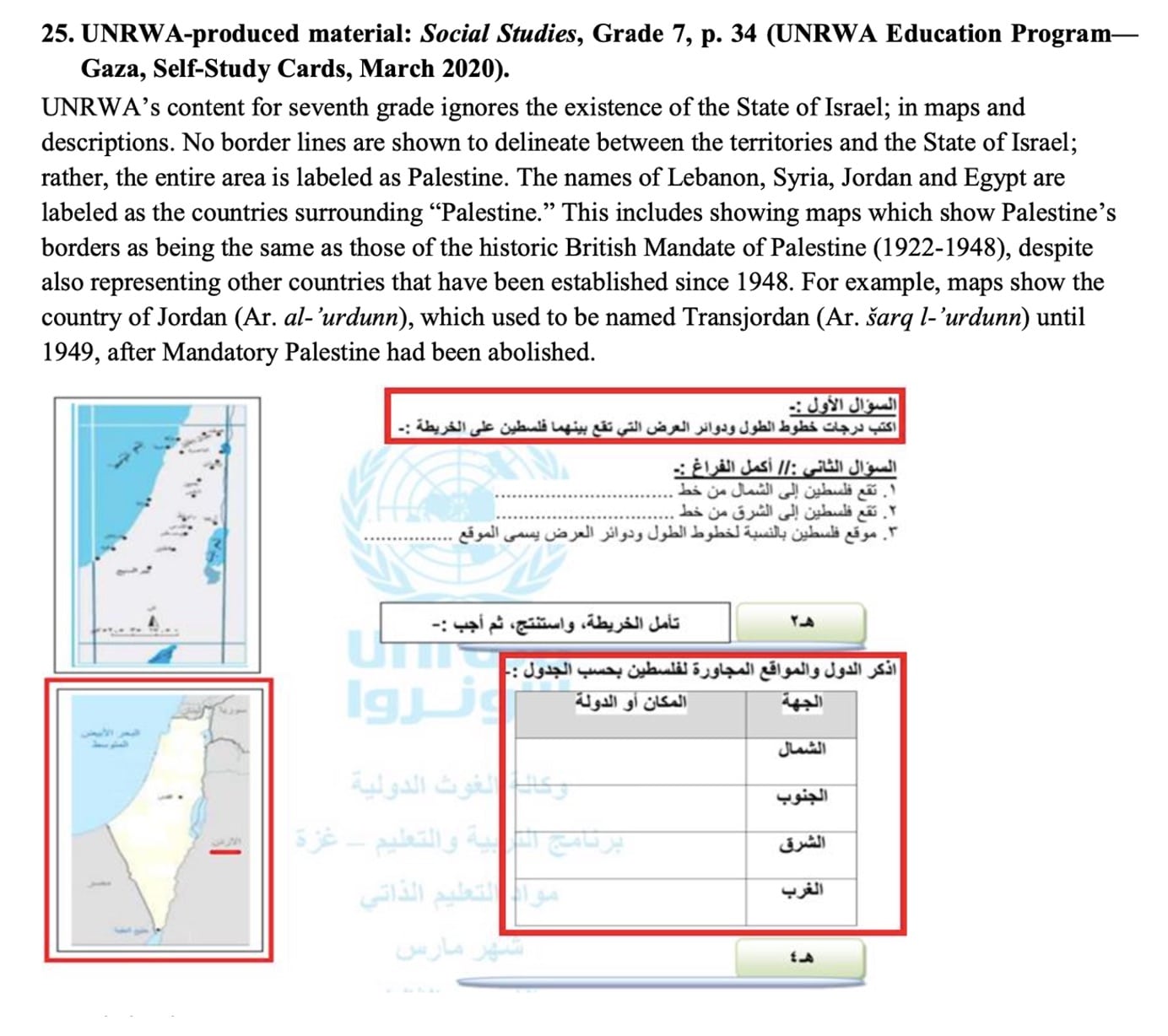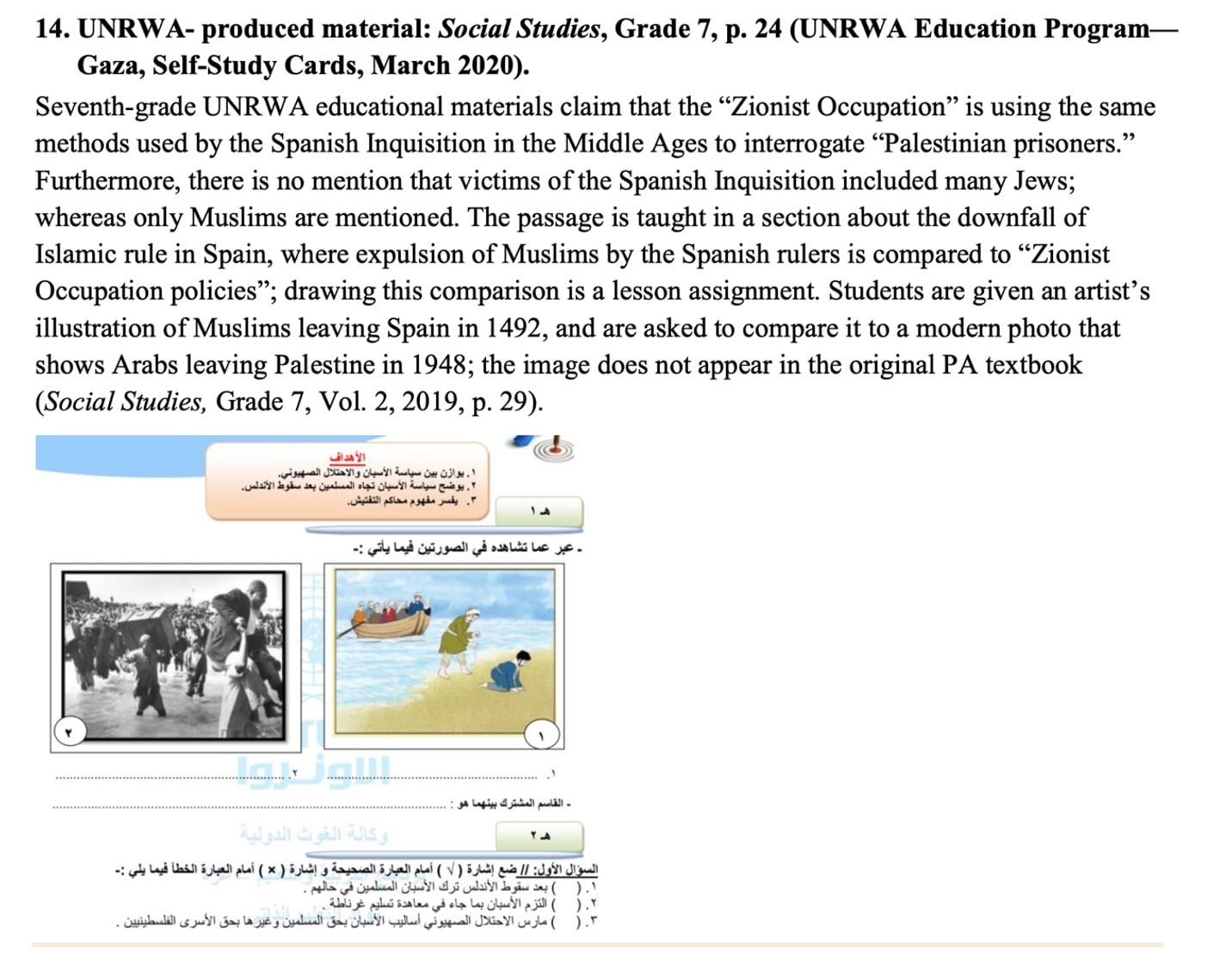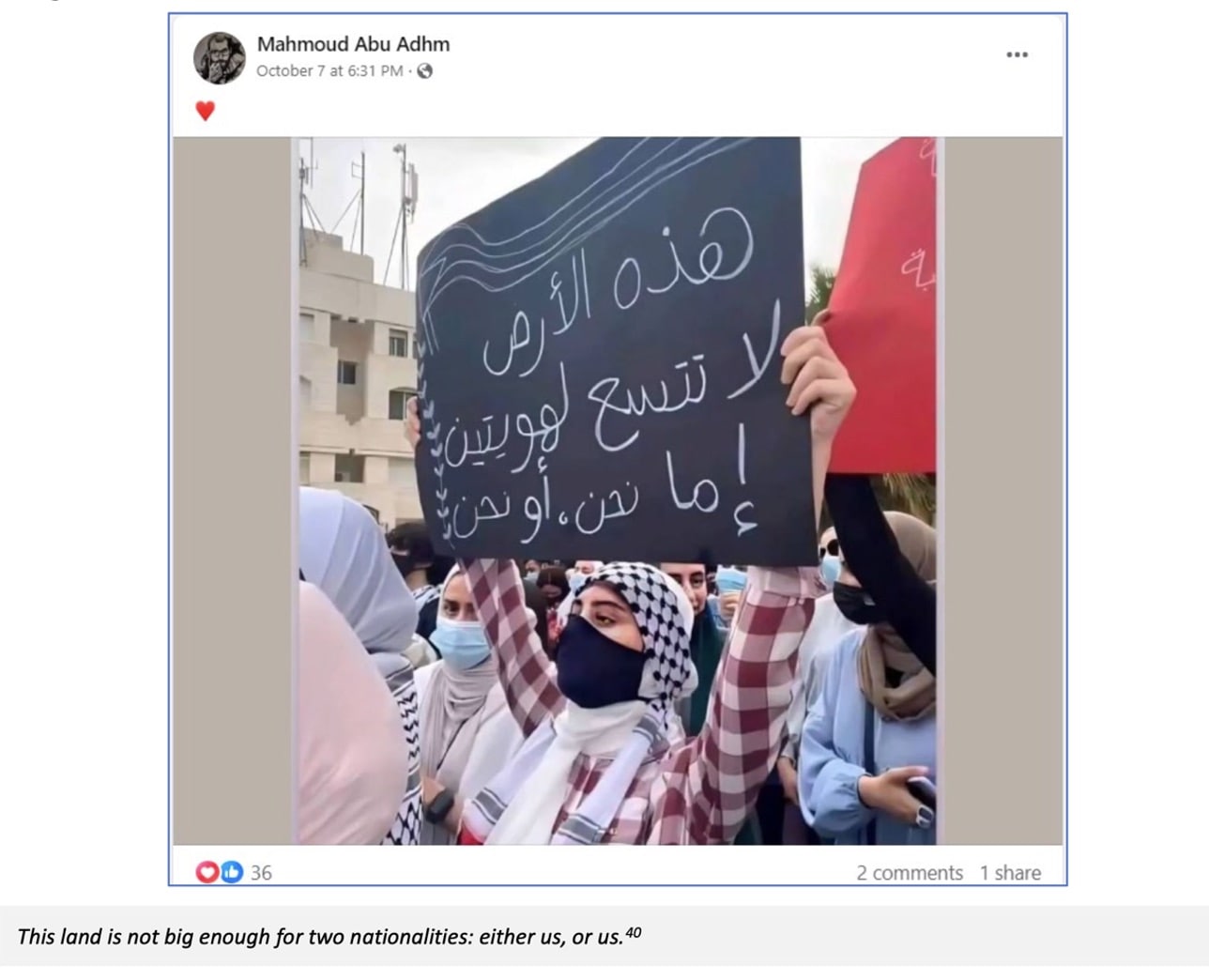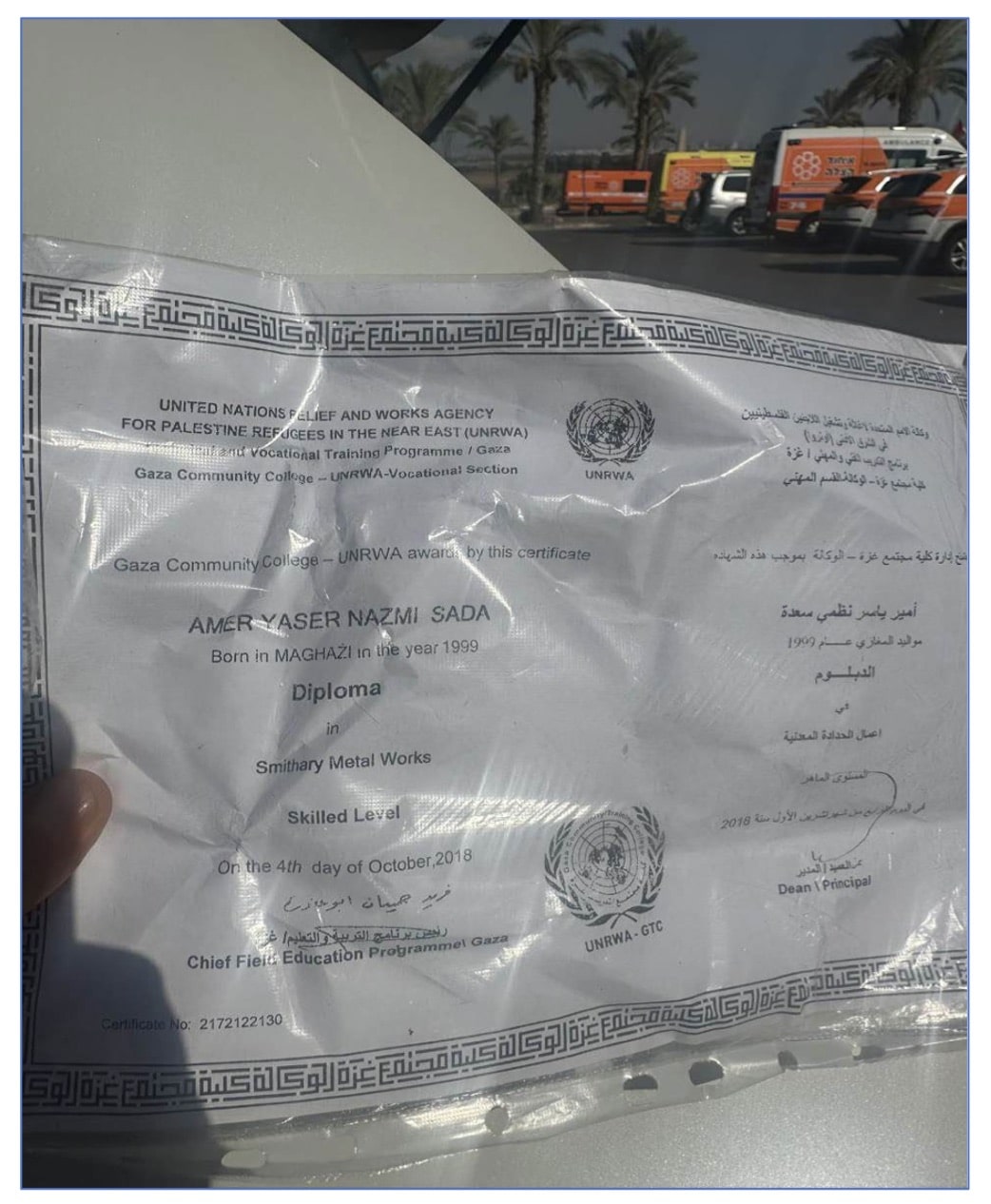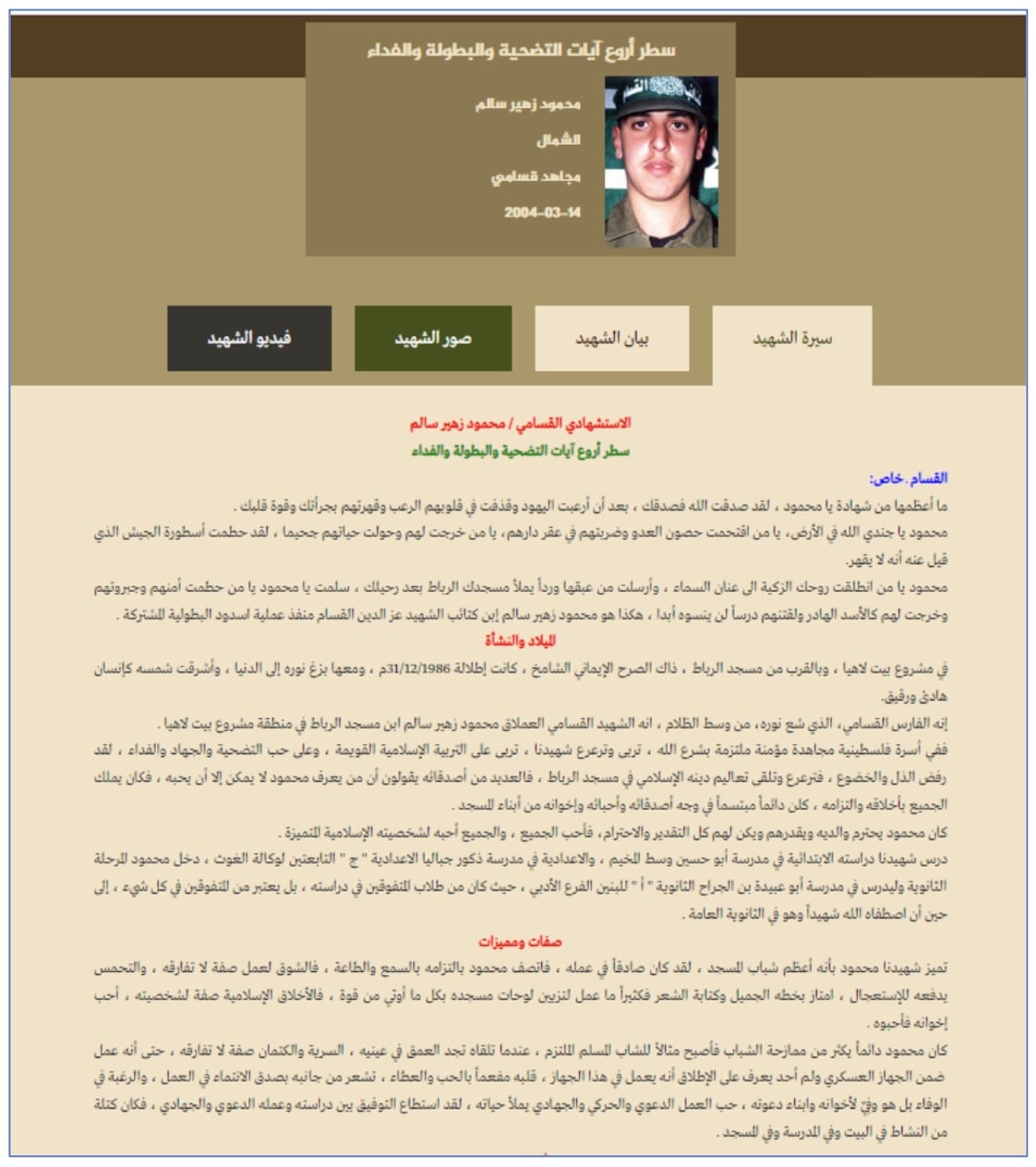What is being taught in Palestinian schools?
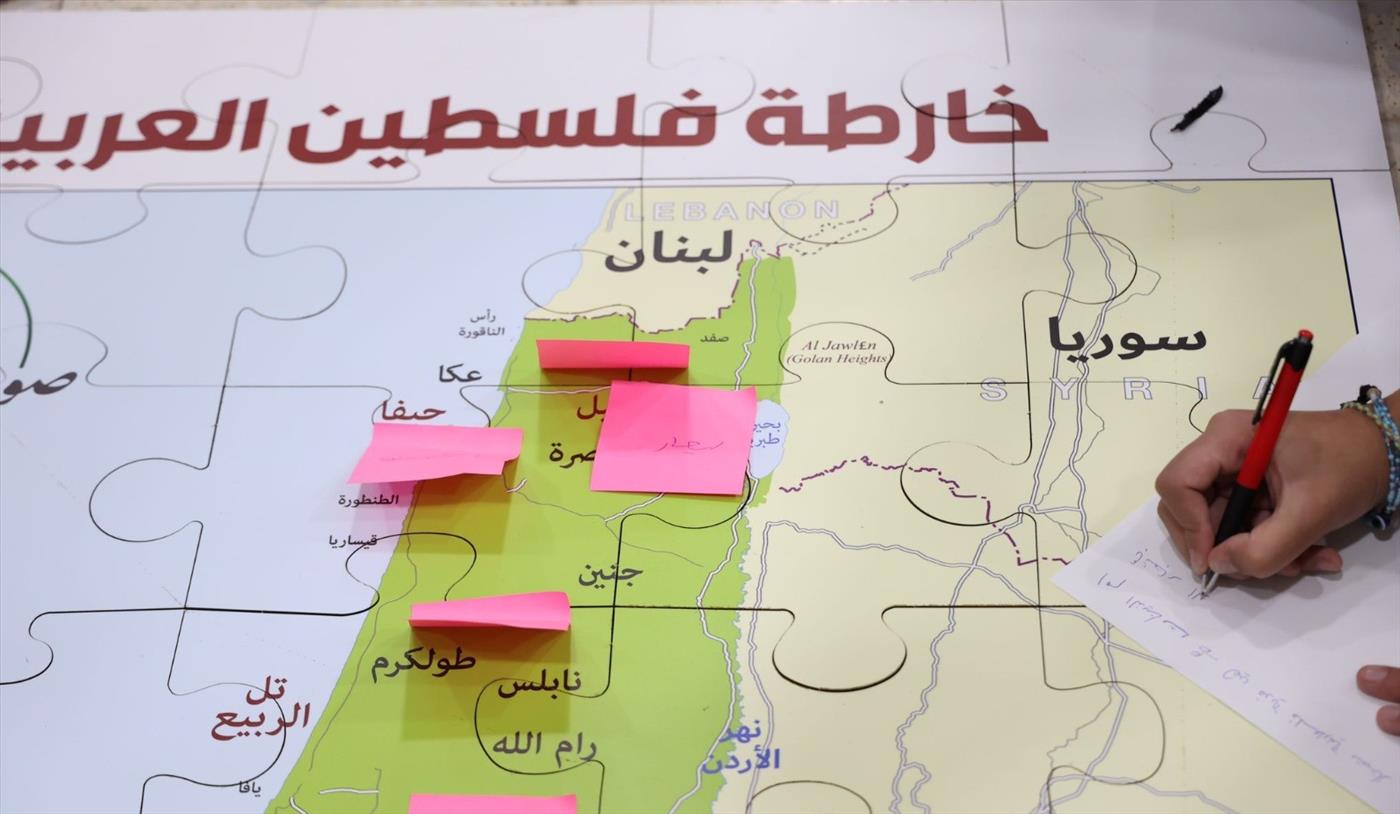
The events of October 7th practically undermined the concept of maintaining the status quo, born after the failures of the peace processes in the 2000s initiated by the Oslo Accords. The same old, complex questions about the possibility of coexistence are resurfacing. If so, in what configuration? Is peaceful dialogue and recognition possible, and if yes, with whom exactly? Is there hope for a generational change in Palestinian leadership, and what shapes the youth on whom this hope is placed? Let’s delve into the Palestinian education system and study materials that have shaped multiple generations.
Alongside political autonomy in 1994, the Palestinian administration gained autonomy in education. Since 1948, schools in the West Bank have used Jordanian textbooks, while schools in the Gaza Strip have used Egyptian ones. Since 1967, the same programs have been used but underwent thorough censorship by Israeli authorities for extremist and openly anti-Israeli narratives. In 1994, the original, unedited curriculum was reintroduced, with a commitment to develop a new one gradually over several years. In 2000, the first Palestinian textbooks for elementary classes emerged, and by 2006, textbooks for high school students were also developed.
Since then, the Israeli non-profit organization IMPACT-se has closely monitored textbook materials and published regular reports assessing their alignment with UN-stated values such as tolerance, non-violence, and peacebuilding. According to their research, since the first publication, the textbooks have changed negligibly and contain highly aggressive narratives and ideas:
“Our extensive study of PA schoolbooks has consistently shown the systematic inclusion of ideas of violence, martyrdom, and jihad in textbooks across all subjects and grades, as well as the propagation of extreme nationalism and Islamist ideologies throughout the curriculum, including textbooks on science and mathematics; rejection of the possibility of peace with Israel; and the complete omission of any mention of historical Jewish presence in modern Israeli and Palestinian territories.”
Here are some examples from reports over the past few years:
ℹ️ To avoid any doubts regarding the accuracy of the translation provided in the reports and the original texts, we additionally scanned some examples using Google’s image auto-translate feature.
What and how are Palestinian schoolchildren taught?
Glorification of martyrs, ideals of jihad, praising death
Pupils are taught numbers, and in one assignment, they are asked to choose the correct number of “martyrs of the First Intifada” from the options provided.
Pupils are asked to complete grammar exercises with the main topics being jihad, martyrdom, prisons and conflict.
Death is described as better than life in the chapter glorifying the Palestinian martyrs. Those who seek to live fruitful, peaceful lives instead of following the path of the martyrs are criticized. “To drink the cup of bitterness with glory is far sweeter than a pleasant long life accompanied by humiliation.”
The textbook invites reflection on the topic of when jihad for the liberation of Palestine becomes the duty of every Muslim.
Death is presented as something predetermined. Choosing the path of jihad is presented as a courage that does not shorten life, but only makes it more meaningful.
The textbook glorifies Dalal al-Mughrabi, who carried out the terror bus hostage-taking in 1978 that killed 38 Israelis and wounded 72.
The textbook contains a heart-circled picture of Izz al-Din al-Qassam, the founder of the jihadist movement, after whom the military wing of Hamas is named. Students are asked to find information about him and write in the appropriate fields, e.g., “date of martyrdom.”
Denial of Israel's existence, the historical and cultural connection of Jews to the land of Israel, historical distortions
The name Israel and any mention of a Jewish state is absent from maps. The entire territory of the modern State of Israel is called Palestine. Modern Israeli cities and settlements are hardly depicted on maps.
It is the same in primary school textbooks. The entire territory of modern Israel is portrayed as Palestinian.
Palestine is presented as a state whose borders stretch “from the Mediterranean Sea to the Jordan River” and whose area is 27,000 km² – a number that includes the territory of Israel.
The textbook cites a photograph of the Hasan Beck Mosque in modern Tel Aviv as an illustration of the Palestinian city of Jaffa, which “Arab ancestors built 6,000 years ago.”
Jerusalem is presented as a city built by Arabs thousands of years ago and sacred to Muslims and Christians.
The struggle in everything: the arithmetic of martyrs, the physics of stone throwing, the biology of clashes with the Israeli army
Pupils are asked to count not apples or candies, but martyrs and prisoners in Israeli prisons.
Elastic strain energy and acceleration calculations are explored through stone-throwing at protests. Sound waves – through calls to prayer at the Al-Aqsa Mosque, allegedly silenced by Zionists.
The functioning of the human body is explored through the extreme conditions people find themselves in while clashing with the Israeli army. The benefits of water and salt are explored through the hunger strikes of prisoners in Israeli jails.
This is only a tiny portion of the examples from the two reports. More reports and examples can be found on the IMPACT-se website. In its quantitative analysis, the organization found more than 2,700 formulations across all textbooks that refer to violence and aggression in some way.
How is the Palestinian education system organized?
Palestinian education is divided into primary schooling from grades 1-10, high school grades 11-12, and university or technical college. Schools are divided into three types depending on who runs them: the Ministry of Education under the Palestinian Authority (74%), UNRWA (UN Relief and Works Agency for Palestine Refugees in the Near East) (13%), or private individuals (13%). As of 2021, the number of schools was 3107, the number of students was about 1,338,000, and the number of teachers was 59,098.
The Palestinian Ministry of Education was established in 1994. One of the first ministers of education in the early 2000s was Nasser al-Shayer, who had a doctorate in religious studies from Manchester University – he studied the role of women in Islam and Judaism. In addition to his position as education minister, al-Shayer was also a member of Hamas.
After Hamas seized power militarily in 2007, the PA removed all Hamas members, including al-Shayer, from ministerial positions. Since then, ministerial positions have been held either by independent candidates or Fatah members. Fatah minister (2014 – 2019) Sabri Saidam has repeatedly stated that all of Israel’s territory is “Palestine” and has spoken of the need to remove Israel from the maps and the importance of glorifying the “martyrs.”
In the Gaza Strip, the position of Minister of Education, like those of other ministers, has been held by Hamas members since 2007. For all these years, the Minister of Education was a member of the Hamas political wing, Osama al-Mazini, who was also responsible for negotiating the prisoner exchange deal for soldier Gilad Shalit. The Israeli army eliminated him at the end of October 2023.
Criticism, response to criticism and actions taken
Since the publication of the first textbooks, the educational program of Palestinian schools and the materials used in their teaching have been the subject of much criticism. A debate has developed around the Palestinian textbooks between those who believe that the use of the examples mentioned above is unacceptable and those who see some legitimization in it.
In 2021, Germany’s Georg Eckert Institute (GEI) for International Textbook Research conducted an EU-funded research cited by UNWRA, some politicians, non-profit organizations, academics, and journalists, including quoted in an op-ed in the Israeli newspaper Haaretz.
The report gives many examples of impressive passages about human rights, tolerance, and acceptance of the other. As for the examples highlighted in the IMPACT-se reports, GEI also publishes plenty of them but reaches quite the opposite conclusions. For instance, the study identifies examples of confrontation with the Israeli army in science textbooks as a legitimate practice of using real-life examples in education. The report’s findings give a rather vague or non-existent assessment of the glorification of martyr culture, notions of jihad, and ignoring the existence of Israel.
In general, most opinions expressed about Palestinian textbooks contain a subjective assessment of the acceptability of the materials in the context of the Palestinian-Israeli conflict and one’s position on it rather than an assessment of the educational environment and the effects of broadcasting politicized aggressiveness and violence.
In 2017, Palestinian Authority Education Minister Sabri Saidam responded to the criticism and said that Palestinian textbook materials “reflect Palestinian identity” and that those labeled terrorists (by Israel) are “martyrs and national heroes” from the Palestinian perspective and vice versa.
This correlates with the rhetoric of IMPACT-se’s critics, who claim that their research does not provide sufficient context and seems unacceptable only to the Israeli side. It is worth mentioning that IMPACT-se monitors educational materials in many other countries (including a recent study of Russian and Ukrainian textbooks). The aim of the organization’s reports is that textbooks around the world, including the Palestinian school curriculum, should stop using propaganda materials and create a safe, pluralistic educational environment, as they say in their response to the UNWRA statement.
Despite years of debates on the topic, Western countries’ political circles tend to favor the unacceptability of such materials, which is reflected in the policies and measures taken.
In 2018, the administration of US President (at the time) Donald Trump precluded annual US support for UNWRA of $360 million (one-third of their $1.1 billion annual budget). However, the administration of current US President Joe Biden resumed partial support in 2021. Other large donors to UNRWA and the Palestinian Authority on education issues are EU countries. In May 2023, the European Parliament, for the fourth time, adopted a resolution condemning Palestinian school curriculum textbook materials and calling for radical reforms under the renewed threat of another funding freeze.
Last year, however, the funds were unfrozen with no conditions on the reissuance of teaching materials.
Nevertheless, the events of October 7 have once again raised questions about the funding of the Palestinian Authority and its education system. In the immediate response to the Hamas attack, the EU froze €691 million in budget transfers.
The scale of terror and brutality against #Israel and its people is a turning point.
There can be no business as usual.
As the biggest donor of the Palestinians, the European Commission is putting its full development portfolio under review, worth a total of EUR 691m
⤵️— Oliver Varhelyi (@OliverVarhelyi) October 9, 2023
A month ago, the US House of Representatives passed a bill requiring the US Secretary of State’s office to audit Palestinian school materials yearly and provide a report on which funding would depend. The House Foreign Affairs Committee held a panel discussion on the issue of propaganda.
Among Israeli politicians after 7 October, Israeli opposition leader Yair Lapid spoke on this: “Israel will not accept that the Palestinian Authority will take part in governing life in Gaza until an extensive de-radicalization program is implemented in the Palestinian Authority, which will include education against incitement.”
Elon Musk spoke about Palestinian children raised by propaganda and the need for change during his visit to Israel in late November: “Basically, these people have been fed propaganda from childhood. And it’s amazing what people are capable of if they are fed lies: from childhood, they will think that killing innocent people is a good thing[…] We need to change the education system so that new generations are not taught to become killers[…]”.
Criticism of UNRWA
For many years, UNRWA has been the most criticized institution in terms of education. It is responsible for the annual education of over 300,000 Palestinian schoolchildren and half of the Gaza Strip schools. As a UN entity, it is committed to delivering education in line with the organisation’s values.
The organization itself states the following:
“UNRWA schools in the West Bank aim to create a democratic school culture and develop civic and leadership skills, enabling Palestinian refugee children to face the future with purpose and hope. To this end, the Human Rights, Conflict Resolution and Tolerance program was introduced to develop student’s knowledge, skills, and attitudes towards a culture of human rights, non-violence, healthy communication skills, and peaceful conflict resolution.”
One of the organization’s principles regarding education is that they use local curricula and textbooks in their schools, i.e., Syrian in Syria, Lebanese in Lebanon, and Palestinian in the West Bank and Gaza Strip, respectively. In response to criticism of using Palestinian textbook materials contrary to UN values, they have repeatedly emphasized the difficulties in this regard:
“Ensuring that the educational materials used in UNRWA schools align with UN values has caused difficulties in the West Bank. As in other regions, in the West Bank, UNRWA follows the host entity’s curriculum. The Palestinian Authority Ministry of Education, as part of the overall education reform, has begun the process of changing its curriculum and has been releasing new textbooks in phases since 2016.[…] In addition to regular reviews of the curriculum framework, rapid reviews of newly released textbooks have been initiated on several key criteria, including neutrality, open-mindedness, and age appropriateness.”
However, according to repeated IMPACT-se studies, UNRWA’s measures to monitor and replace unacceptable materials are opaque and insufficient.
A report by the US Government Accountability Office (GAO) on the treatment UNRWA of problematic PA materials published in 2019 states that UNRWA “is taking action to address content that is inconsistent with UN values” by creating “supplemental educational materials such as alternative photos, examples, and guidance for teachers on how to use textbooks in schools UNRWA.” However, the report also claims that “UNRWA does not train teachers or distribute supplementary educational materials in classrooms. As a result, these materials are not actually used.”
As part of its education reforms in 2011, UNRWA launched an initiative to promote “alternative learning methods,” including but not limited to self-learning, to enable students to continue learning during emergencies such as armed conflict. UNRWA’s first “Self-Study Cards” became available in 2020. IMPACT-se also researched them and found them to be almost identical to materials in other Palestinian textbooks.
Study materials
Themes of martyrdom and jihadism are still glimpsed in the cards.
On maps, the entire territory of the State of Israel is referred to as Palestine.
The 6th grade textbook describes the ancient civilizations of the region, but does not mention the Jews, and refers to the Canaanite peoples as Arab tribes, which is historically incorrect.
Speaking of the Spanish Inquisition, textbook is not only accusing Israel of “using the same methods to interrogate Palestinian prisoners,” but also omits that the victims of the Inquisition included Jews, and compares the events of 1492 with those of 1948.
The UNRWA also allows knowingly false information in its cards, such as blaming Israel for the 1969 arson attack on the Al-Aqsa Mosque, even though it has been proven that an Australian Christian, Denis Rohan, was responsible for the attack.
Educators and school staff of UNRWA – who are they and how did they respond to the October 7 attack?
Obviously, not only teaching materials but also educators play a significant role in education and personality formation.
In multiple reports by IMPACT-se and UN Watch (2015, 2017, 2021, 2022), workers and teachers at UNRWA schools, the vast majority of whom are locals, have been repeatedly caught espousing extremist views and promoting violence.
The last such report was issued in November 2023. Here are some examples from it.
Mahmoud Abu Adhm is a civil engineer and UNRWA employee living in Gaza. Since Hamas attacked Israel on October 7, he has made several posts on his social media accounts supporting the terrorists. In one of his posts, he publishes an image of a Palestinian woman holding a placard that reads, “This land is not big enough for two nations.”
In another post on October 10, he calls on Hamas to kill Israeli hostages, citing the Koran: “Do not pass by a prisoner who has not been pardoned without cutting off his neck to intimidate the enemy of God and your enemy.”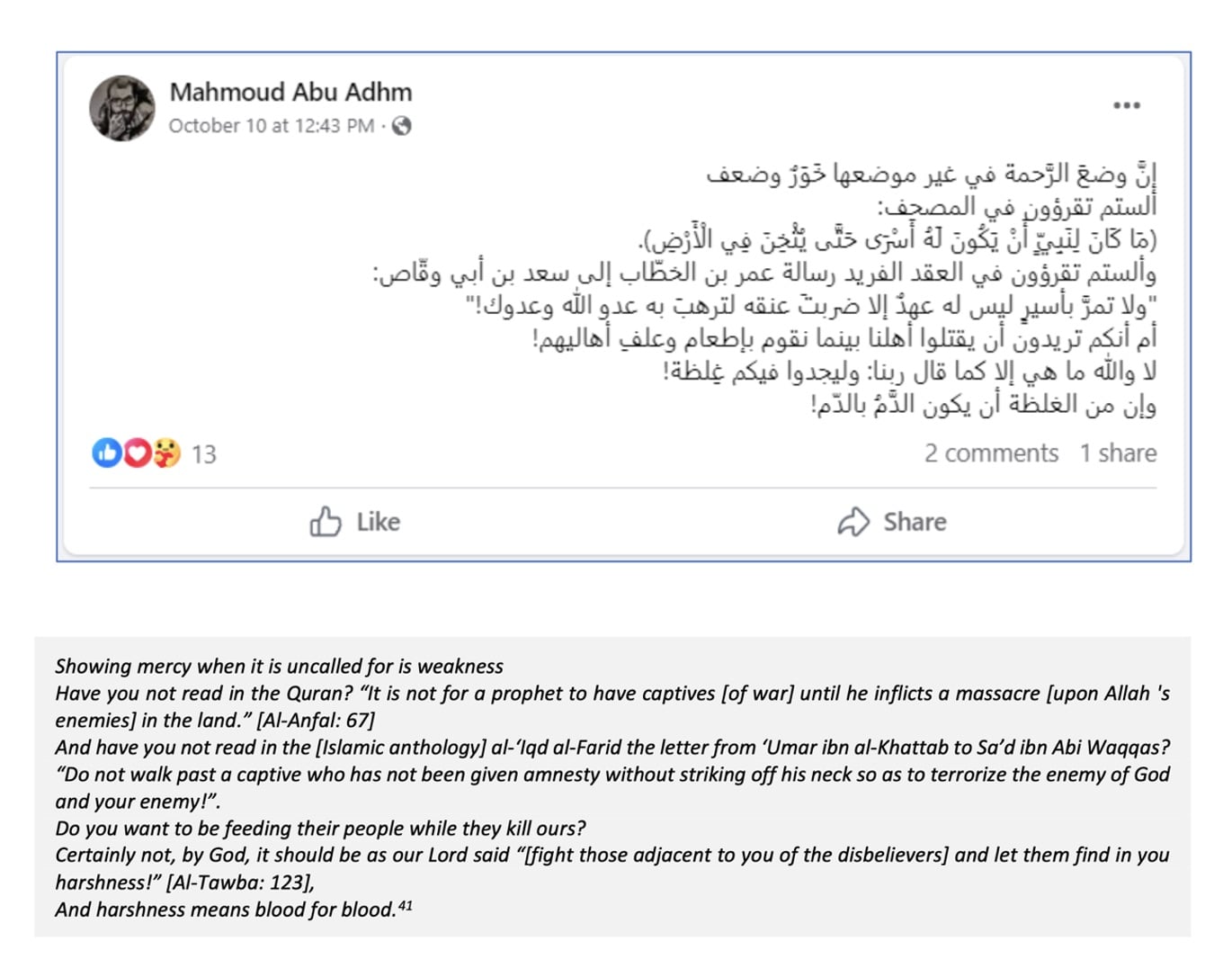
Sarah Alderawy is an UNRWA teacher. She has repeatedly published posts calling for violence. For example, on the morning of October 7, she reposted a video showing the destruction from a rocket fired from Gaza into Israel and Hamas terrorists shooting Israeli cars. A quote from the Quran accompanies the video: “Return to them, and we will surely arrive with an army before which they will not resist, and drive them out of there humiliated and insignificant.” [An-Naml: 37].
Halima M. Sharbain is a social worker and nurse at an UNRWA school in Gaza. On the morning of October 7, she published a post calling for “the safety of Gaza and its jihad warriors” and urging Gazans to “renew the intention of ribat [defensive jihad].”.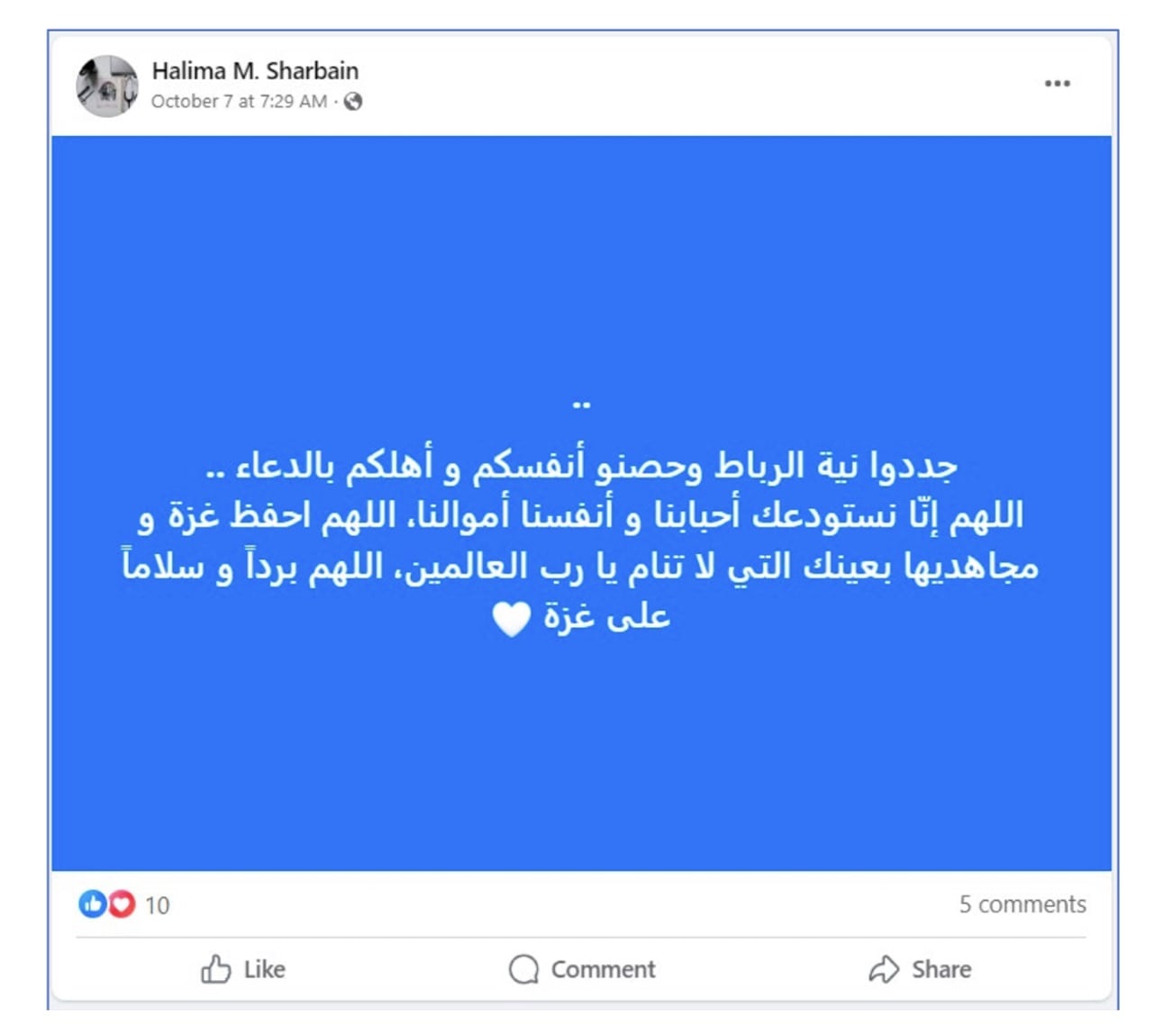
Abu Alqaysar Badawi, like his wife, is an UNRWA teacher from Ramallah. On October 11, he published an Al Jazeera channel video from 2018 showing IDF soldiers injured in an explosion near a Palestinian flag placed on the Gaza-Israel border. He accompanied the footage with the caption, “Praise be to Allah, His Messenger, and the believers.”
Terrorist alumni
One might assume that textbooks and teachers supporting the actions of Hamas do not guarantee that students in those schools become terrorists themselves. However, there is evidence to the contrary.
A 2018 diploma from UNRWA College in Gaza was found in the car of one of the terrorists involved in the October 7 attack.
Hassan Suleiman Katnani is listed on the official website of the military wing of Hamas. His biography states that he attended a UNRWA school. His father is also a UNRWA employee and is the son-in-law of Qatar-based Hamas Politburo member and spokesman Hossam Badran, who was released in exchange for Israeli soldier Gilad Shalit. Katnani was one of the masterminds behind the attack on the Dee family on April 7, 2023, in which three family members were killed. During the attack, gunmen opened fire on the vehicle carrying Lucy Dee and her two daughters, Maya and Rina, at close range, firing a total of 22 bullets from a Kalashnikov assault rifle. Maya and Rina were killed instantly, and Lucy died of her injuries three days after the attack.
Mahmoud Zuhair Salem is also listed on the website of Hamas’ military wing, the Al-Qassam Brigades. His biography states, “he was taught to love jihad and self-sacrifice.” The former UNRWA school student was one of the organizers of the 2004 Ashdod port bombings that killed 16 Israelis. He was only 18 years old at the time.
It is worth noting that the report provides information on more than 100 terrorist UNRWA school alums.





